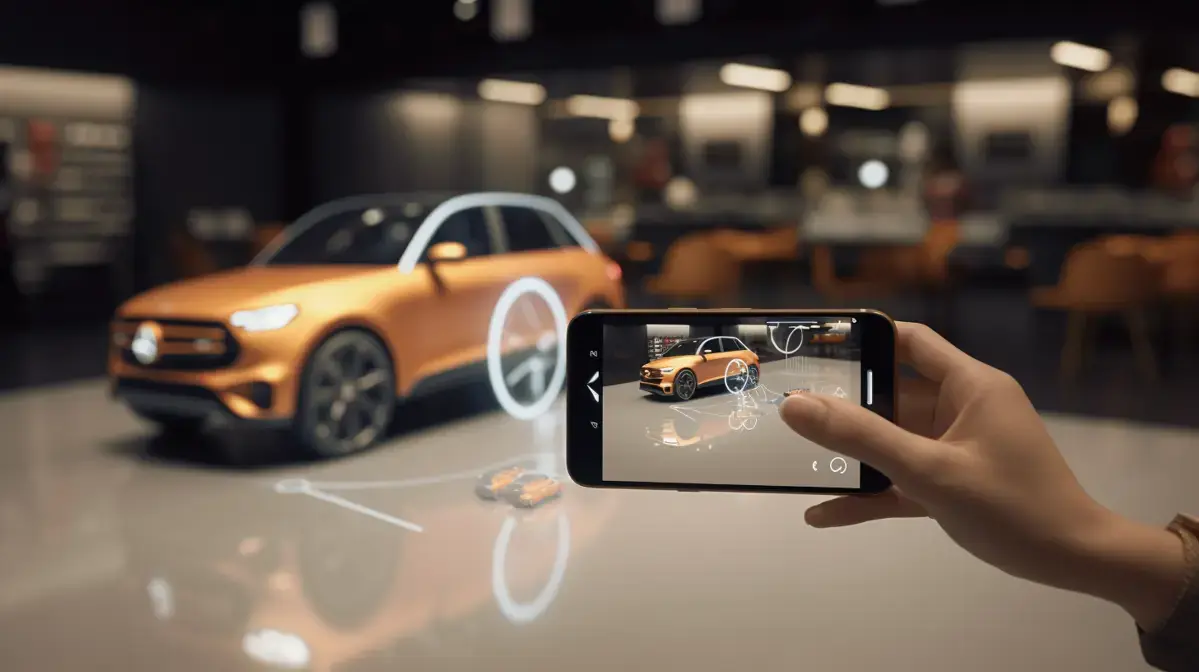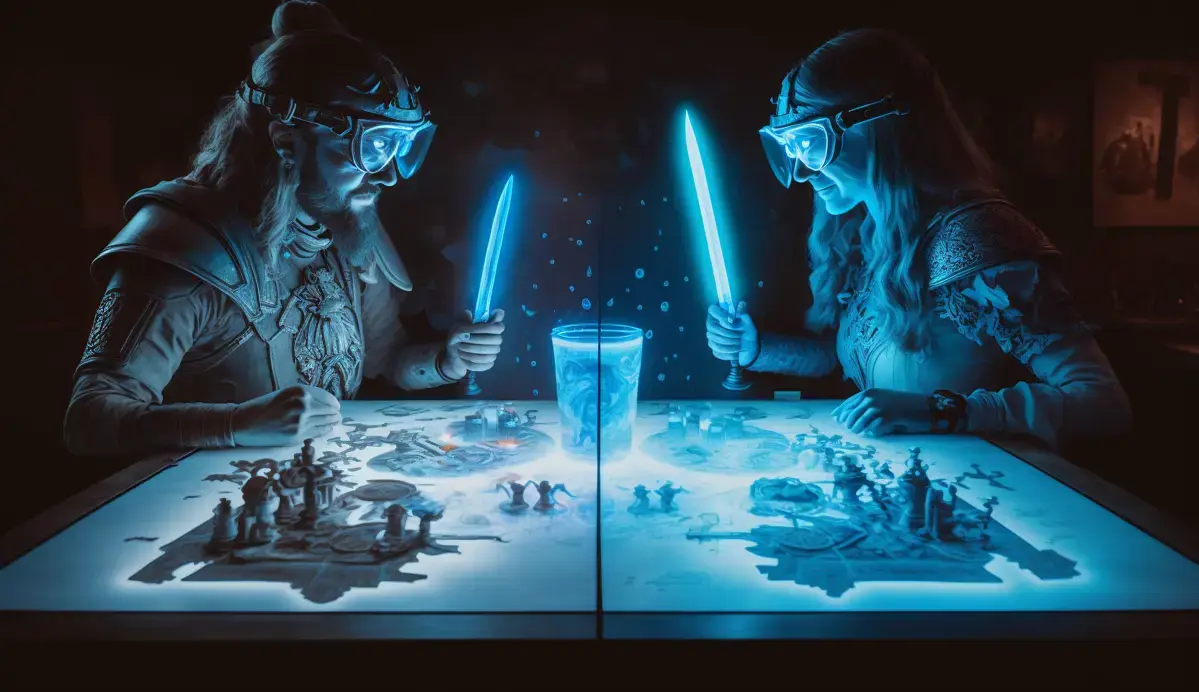Augmented reality technology has evolved tremendously in the last few years, but it still faces some challenges and limitations. One of the main issues is its performance on different devices. AR apps require a lot of power to run smoothly, which means that they may not work well on low-end smartphones or tablets.
However, one performant feature of AR technology is its ability to enhance user experiences by adding digital elements into real-world environments. This can be particularly useful in industries like education, healthcare and retail where it’s important for users to interact with virtual objects as part of their learning or buying experience.
For instance, augmented reality can help medical students learn complex procedures by creating immersive simulations that show them how these procedures are conducted step-by-step. In retail stores, shoppers can use AR apps to virtually try on clothes without having to physically go into a fitting room.
While augmented reality technology still faces some challenges regarding device compatibility and processing power requirements; there are many innovative ways in which this technology enhances user experiences across various sectors including education and healthcare among others Check out Argeopin.com for more insights about augmented Reality.
Table Of Contents
- Key Points
- Enhancing Situational Awareness on the Battlefield with AR Integration
- Future Possibilities for Augmented Reality in Military Logistics
- Introduction: Understanding Augmented Reality Technology
- Interesting Facts
- The Technical Challenges of Developing Augmented Reality Applications
- Limitations in Hardware Capabilities for Immersive Augmented Reality Experiences
- User Experience and Interface Design Limitations in Augmented Reality
- FAQs
- Ethical Concerns with the Use of Augmented Reality Technology
- The Cost Barrier to Accessing High-Quality Augmented Reality Experiences
- Future Developments and Advancements in Overcoming the Challenges of Augmented Reality
- Key Takeaways

Key Points
- Augmented reality technology is still in its early stages and has limitations.
- The current hardware for AR technology can be bulky, expensive, and not accessible to everyone.
- A limited field of view can restrict the user’s experience and impede immersion.
- Maintaining accurate tracking of objects in a changing environment poses a challenge to AR developers.
Enhancing Situational Awareness on the Battlefield with AR Integration
Augmented Reality (AR) is an innovative technology that has been gradually finding its way into military applications. Military logistics, in particular, have seen a significant transformation with the incorporation of AR systems. These technologies provide real-time data and facilitate seamless decision-making processes for soldiers on the ground.
For instance, AR can be used to quickly identify targets by overlaying digital images onto actual terrain features or other real-world objects. This provides soldiers with enhanced situational awareness and helps them make informed decisions based on accurate information rather than guesswork.
Additionally, AR-enabled logistics systems can help enhance supply chain management by providing detailed information about inventory levels and locations in real-time. This means that any logistical issues can be resolved far more efficiently than ever before – ultimately leading to improved mission outcomes.
To illustrate this point further: imagine you are a soldier delivering supplies during deployment when suddenly your GPS device malfunctions or loses signal; how would you know where exactly to deliver these supplies? With an AR system integrated within their devices like smart helmets or goggles worn while transporting goods across enemy lines – it’s easy. Soldiers will have access not just direction but also precise location coordinates at their fingertips through augmented reality overlays enabling safe deliveries without wasting time guessing around unfamiliar terrains.
Augmented reality is revolutionising military logistics as we know it today – providing critical insights for informed decision making throughout each stage of operational activities from preparation all through implementation thereby ensuring better safety & efficacy especially during combat missions.
Future Possibilities for Augmented Reality in Military Logistics
Augmented Reality (AR) technology has been revolutionizing various industries, and the military logistics sector is no exception. The integration of AR into military logistics enhances communication and information sharing among troops. It provides real-time contextual data that can significantly improve situational awareness on the battlefield. For instance, soldiers wearing AR-enabled helmets or glasses can get instant access to location-based intelligence such as maps, weather conditions or enemy positions without having to look away from their tasks.
Furthermore, Augmented Reality simplifies training for new recruits by providing virtual simulations which replicate real-world conditions they might face during deployment overseas. A good example is how Microsoft’s Hololens 2 was used in training US Marines using live fire exercises; it not only made them more efficient but also safer than traditional methods.
With these benefits and others like improved speed & accuracy when handling complex logistical processes(I.e cargo supply routes), one would wonder why every army unit isn’t deploying Augmented reality already? Well. I’m afraid its a slow process integrating old systems with new ones plus security concerns are always at play
Despite challenges faced when implementing Ar techs there’s no denying once fully integrated platforms like Hololens 2 will change warfare as we know it forever.
Introduction: Understanding Augmented Reality Technology
Augmented reality technology, or AR as it’s commonly referred to, is changing the way we interact with our surroundings. With its ability to merge digital information with real-world objects and environments, AR has opened up new possibilities in various industries such as gaming, healthcare, education and tourism.
From mimicking dance moves on Snapchat filters to Pokemon Go Mania that swept across the world a few summers back; you’ve probably experienced some form of AR without even realizing it. But understanding what makes this technology so impressive requires a deeper examination of how it works.
At its core Augmented Reality uses advanced computer vision algorithms paired with motion sensors that overlay 3D graphics onto a user’s real-time camera view- A bit like placing stickers on top of your live video feed using snapchat lenses. This enables users to experience an immersive blend between virtual and physical worlds. The more sophisticated use cases allow individuals or businesses create their own ‘worlds’ which can be personalised for different groups – think fashion brand creating personal shopping experiences for customers by letting them try outfits from home before purchasing.
No longer just science fiction – Augmented Reality offers endless opportunities for innovation- whether used recreationally or commercially there really are no limits when imagining the possibilities.
Interesting Facts
- The first head-mounted display (HMD) for augmented reality was developed in 1968 by computer scientist Ivan Sutherland.
- In 2016, the global market size of augmented and virtual reality was valued at approximately $5 billion. It is projected to reach over $200 billion by 2027.
- Augmented reality technology has been used in various industries including healthcare, education, entertainment and tourism among others.
- Military forces across the globe have implemented AR technology to enhance training simulations for soldiers. This includes simulated combat scenarios that allow soldiers to practice their skills without actually being put in harm’s way.
- AR technologies are also becoming popular with museums and galleries as they can be used to bring exhibits alive with additional information or immersive experiences for visitors.

The Technical Challenges of Developing Augmented Reality Applications
Augmented reality (AR) is a cutting-edge technology that promises to change the way we interact with our environment. The concept of augmented reality involves overlaying digital information onto the real world through devices such as smartphones, smart glasses or headsets. AR has already shown its potential in various fields such as education, entertainment and marketing.
Augmented Reality apps have made shopping more engaging than ever before. Imagine being able to try out different outfits on yourself without changing clothes physically – sounds too good to be true? With augmented reality technology at your disposal via smartphone cameras or smart mirrors available in stores nowadays- trying out any attireis just one tap away.
All these examples illustrate how Augmented Reality Technology works towards elevating users’ emotional responses while simultaneously simplifying tasks that were previously tedious; hence, opening doors for endless possibilities across various sectors. From healthcare innovations assisting medical personnel during surgeries and supplying data-driven analysis aiding patient recovery times management, to revolutionizing online retail experiences promising seamless user involvement through virtual trial rooms.
In essence, Augmented Reality Technology adds another dimension of interaction between humans and their surrounding environments leading us closer towards realizing sci-fi-like realities one step at a time.
Limitations in Hardware Capabilities for Immersive Augmented Reality Experiences
Augmented reality technology (AR) has become a buzzword in recent years. AR offers an entirely new and exciting way to interact with the world, by enhancing real-world objects with computer-generated information, creating unique experiences that were once impossible. Understanding how this technology works is essential for grasping its potential.
To put it simply, AR overlays digital elements onto the physical world around us through devices like smartphones or smart glasses. It can be used in various fields like education, healthcare, entertainment and beyond to improve our lives drastically.
An example of how AR is changing the game can be seen in educational settings where students use augmented reality-enabled textbooks that showcase immersive 3D models of complex structures such as human anatomy or chemical compounds – revolutionizing traditional classroom learning methods.
As an expert on the subject matter, one cannot help but get excited about what’s to come from this groundbreaking tech- from interactive museums exhibits to virtual shopping experiences -the possibilities are endless.
User Experience and Interface Design Limitations in Augmented Reality
Augmented reality is a technology that has been around for quite some time, yet it still remains an enigma to many people. To put it simply, augmented reality enhances the real world with computer-generated content such as images and videos. It allows users to interact with these virtual elements in real-time using their smartphone or other devices.
One of the most exciting aspects of AR technology is its ability to create immersive experiences. Imagine walking down a street and seeing virtual creatures popping up on your screen, interacting with them as if they were part of your physical environment. Or imagine trying on clothes virtually before making a purchase decision- this feature alone has revolutionized online shopping.
AR technology also offers numerous benefits in industries such as education, healthcare and manufacturing – allowing students to visualize complex concepts better or doctors operating more efficiently by getting live updates about patients during surgery.
I cannot help but be amazed at how far we have come since Augmented Realities inception. Whether you’re looking for new ways to entertain yourself or searching for solutions that make mundane tasks easier; AR is undoubtedly paving the way towards endless possibilities.
FAQs
1. What are some of the challenges faced by augmented reality technology?
Augmented reality technology faces challenges such as limited processing power, battery life, and connectivity issues. Additionally, there is a lack of standardization across devices and platforms.
2. How does augmented reality affect user’s perception of surroundings?
Augmented reality can distort a user’s perception of their surroundings if not used correctly or if the technology is faulty. It can also lead to disorientation or visual fatigue in some users.
3. Are there limitations to what kind of information can be displayed through augmented reality?
Yes, there are limitations on what kind of information can be displayed through AR due to technical constraints such as display size and resolution limits imposed by current hardware capabilities.
4.How does privacy factor into the use of Augmented Reality Technology ?
Privacy concerns arise with AR due to its ability to capture personal data about users’ physical environment without their permission potentially leading into invasion or theft.

Ethical Concerns with the Use of Augmented Reality Technology
Augmented Reality (AR) is a fascinating technology that has taken the world by storm in recent years. It’s an interactive experience where digital information is overlaid onto the real-world, creating an immersive, enhanced view of reality. Whether it’s exploring new cities with AR-enhanced navigation or playing games like Pokemon Go, AR has become ubiquitous in our daily lives.
As someone who works in this field as an expert and enthusiast for many years now, experiencing the evolution of AR technology has been nothing short of incredible. The ability to witness how augmented reality inspires creativity and innovation across industries such as healthcare with medical training simulations or tourism through engaging virtual tours truly showcases its limitless potential.
Although most people usually associate Augmented Reality with entertainment applications like gaming or social media filters, there are also practical uses like enhancing retail experiences through visualizing products before buying them online or even using holographic interfaces to streamline complex manufacturing processes.
The main appeal behind this cutting-edge technology lies in its ability to merge digital content into our physical world seamlessly. By bridging the gap between what we see on screen and what we perceive around us can create a surreal yet familiar universe that makes you feel both excited and curious at once – not just for gamers but anyone seeking out novel ways for learning about new things.
The Cost Barrier to Accessing High-Quality Augmented Reality Experiences
Augmented Reality (AR) technology is a fascinating and innovative way to blend the physical and digital worlds seamlessly. By superimposing virtual images onto the real world, AR enables users to experience an enhanced version of reality. The possibilities with this technology are endless, from gaming experiences to educational tools, marketing campaigns and even medical procedures.
One of my favorite examples of augmented reality is how IKEA implemented their AR app that allows customers to see what furniture would look like in their homes before purchasing it. This not only revolutionized their customer shopping experience but also reduced product returns significantly as customers could make informed decisions about what they were buying.
The exciting thing about AR technology is its versatility – almost any business sector can benefit from implementing this game-changing tech into its operations or product offerings. For example: imagine you’re attending a conference or event where there’s an overwhelming number of booths- instead of a paper map; you put on your smart glasses that offer directions as you navigate through each exhibit hall.
Understanding augmented reality technologies go beyond just being able to identify them at work when we come across them – knowing these technologies’ capabilities will help us make better-informed decisions both personally and professionally.
Future Developments and Advancements in Overcoming the Challenges of Augmented Reality
Augmented Reality (AR) technology is a game-changer in the world of digital innovation. This cutting-edge field of technology allows users to experience an enhanced reality, where virtual and real-world elements merge seamlessly. AR has already found its place in various industries such as entertainment, healthcare, education and retail.
For businesses looking to implement this innovative form of marketing into their strategy, they’re not alone; many are jumping on board due to its numerous advantages including increased engagement rates from customers who become more invested in brand storytelling when using augmented reality tech, like filters for social media platforms Snapchat or Instagram stories showcasing products before purchase decisions are made easier than ever before.
Understanding Augmented Reality Technology is vital because it’s becoming more prevalent throughout society but mainly essential concerning marketing strategies where brands can create engaging content using filters/filters experiences offered exclusively within these apps increasing customer engagement & sales volumes simultaneously
Conclusion:
Augmented Reality (AR) technology has come a long way since its inception, but it still faces significant challenges and limitations. One of the most significant challenges is the need for high-quality hardware to support AR experiences adequately. This hardware includes sensors, cameras, and displays that can accurately capture and render virtual objects in real-time.
Another challenge is developing robust software platforms that are capable of providing seamless integration with existing systems while also providing a consistent user experience across different devices. Furthermore, there are concerns around privacy issues related to collecting user data through AR applications.
Despite these limitations and challenges facing augmented reality technology today, it remains an area ripe for innovation and development. The potential benefits of AR are enormous – from enhancing learning experiences in classrooms to revolutionizing how we shop online or interact with each other remotely.
As advancements continue to be made in both hardware and software technologies over time – particularly with 5G networks on the horizon – more immersive augmented reality experiences will become possible than ever before.
Ultimately, though, as innovative as this new world may seem, Augmented Reality Technology still requires further investment into research & development coupled together alongside evolving partnerships aimed at breaking down boundaries. If brands want their customers/users/employees, etc., to fully embrace what looks set out to be one of our near future’s most transformational digital tools yet.
Key Takeaways
- Augmented reality technology has the potential to revolutionize various industries, from entertainment to healthcare.
- The challenges of AR technology include limitations in hardware, software, and user experience.
- The cost of developing and implementing AR applications can be prohibitive for small businesses or individuals.
- Data privacy concerns must also be addressed as AR devices collect large amounts of personal information.

